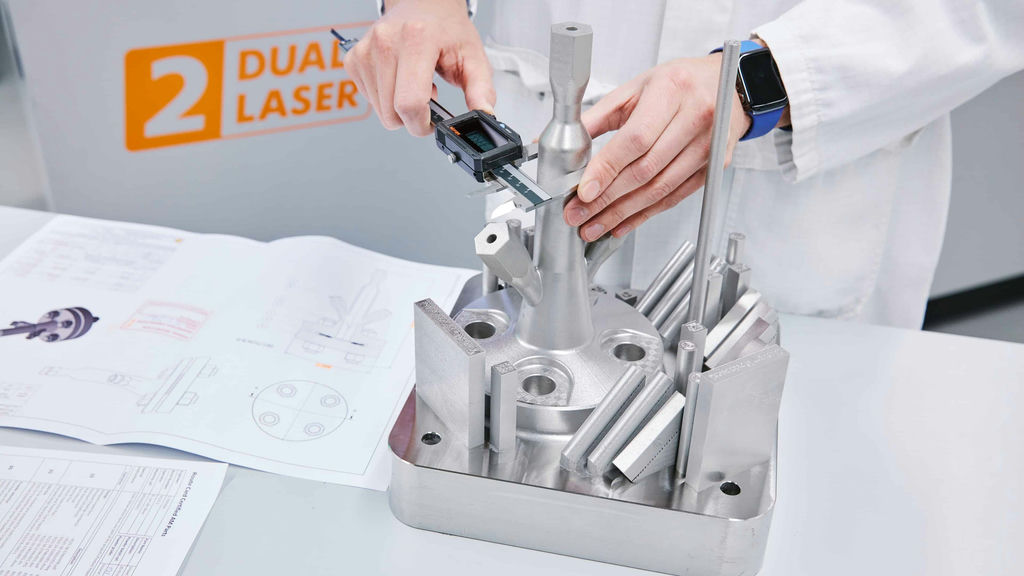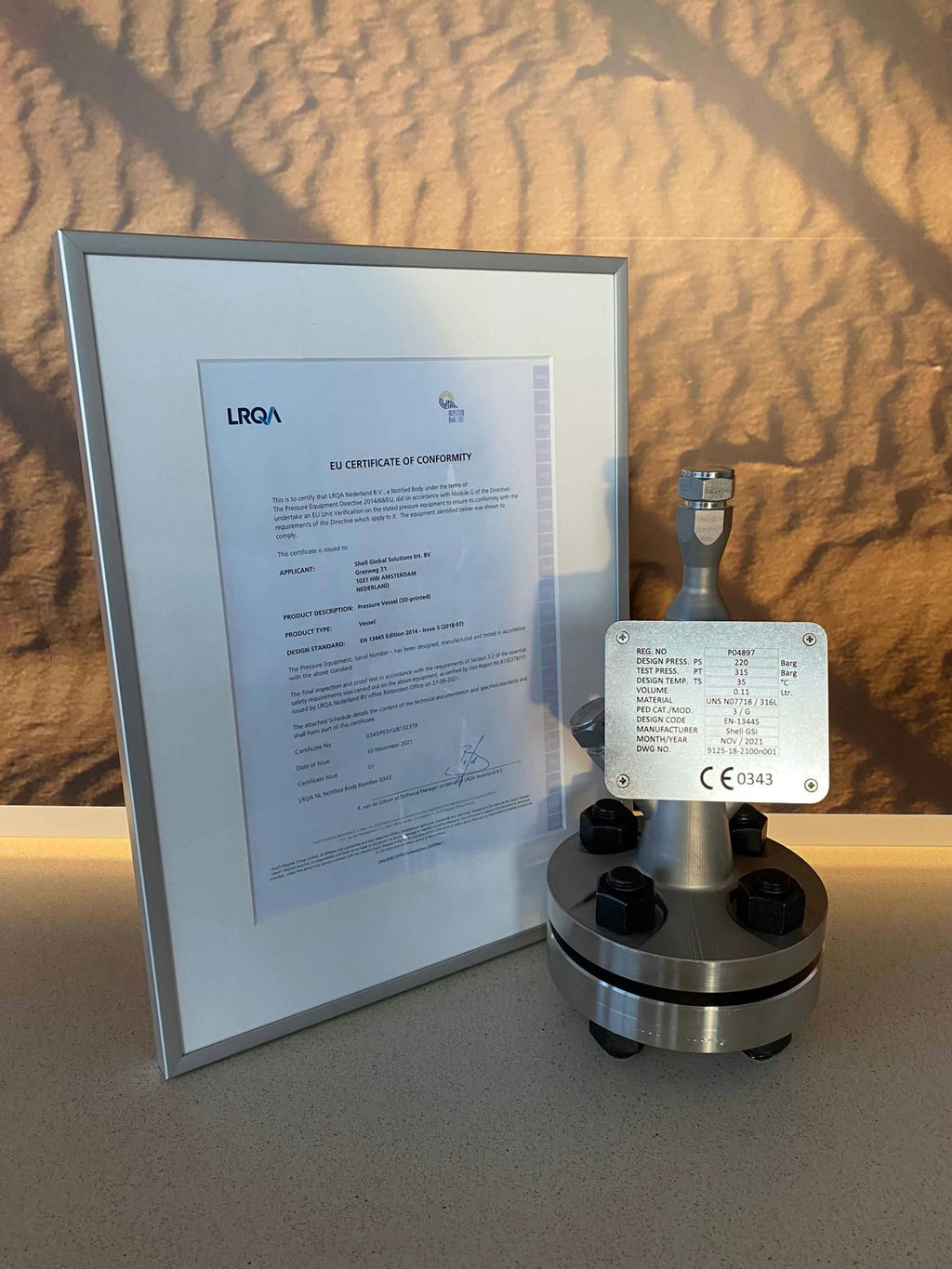Shell is the first company in Europe to have obtained CE certification from a third-party authority for a part 3D printed in-house.
Shell and LRQA (formerly Lloyd’s Register) have certified a 3D printed pressure vessel in accordance with the European Pressure Equipment Directive (PED). This is the culminations of a 4-year collaboration to demonstrate the application of 3D printing in the energy industry. Shell is the first company in Europe to have obtained CE certification from a third-party authority for a part 3D printed in-house. LRQA, acting as a Notified Body, categorized the printed vessel in PED Category III.
“This represents a significant milestone, not only for the additive manufacturing industry but also for the pressure equipment community. This is the first CE Marked pressure vessel approved by an independent Notified Body” explained David Hardacre, Lead Specialist, LRQA. “The journey taken together by Shell and LRQA has been technically challenging but immensely rewarding. We have now established a path for anyone to certify additively manufactured pressure equipment under the PED.”
This represents a significant milestone, not only for the additive manufacturing industry but also for the pressure equipment community.
The vessel was manufactured through Powder Bed Fusion at the Energy Transition Campus in Amsterdam and is designed for pressures up to 220 bar. This certification is an important milestone for the energy industry because there are, to date, no legislation or global standards specifically for 3D printed pressure retaining parts. This lack in regulations means that the use of 3D printed pressure equipment is generally not permitted at industrial assets around the globe. Shell printed this pressure vessel to gather research data that help improve the sector’s trust in additive manufacturing as an technical solution to source spare parts “just in time” instead of stocking the spare parts for years.
Shell runs multiple demo projects with relevant technical experts to gain knowledge in various applications of 3D printing, ranging from spare part management to rapid prototyping and testing novel designs. The work in qualifying the pressure vessel provides valuable data points and insights in support of discussions with standards bodies going forward to scale up the use of additive manufacturing for pressure equipment.
Aditya Chandavarkar, Managing Editor, AM Chronicle got in touch with Angeline Goh, 3D Printing Technology Lead at Shell to get deeper insights about this significant milestone of certifying this 3D printed pressure vessel, not only for the additive manufacturing industry but also for the pressure equipment community.
Aditya Chandavarkar: What were the challenges which were overcome to achieve this certification?
Angeline Goh: Three main challenges were overcome over the course of the research project
1. Getting the primary material approved for pressure purposes
Unlike material bought in batches, tested upfront, with 3D printing, the part is created as the material is printed. Therefore, the formed material must be certified after the pressure vessel is already produced. To approve the primary material, the team printed test specimens in parallel to printing the pressure vessel and used the test specimens to test and approved material properties. The material was then formally approved by the certifier for pressure purposes through the Particular Material Appraisal (PMA) process which is used for non-pre-approved materials.
2. Defining acceptance criteria for defects:
Most pressure vessels must undergo Non-Destructive Testing (NDT) to detect the defects in the material/welds. Although 3D Printing could be compared to welding, the technology has its own unique defects. Therefore, using the same acceptance criteria was not considered appropriate by the certifier. The lack of acceptance criteria for defects limited the certifier in judging if the vessel could be approved. Therefore, the team 3D modelled defects and analysed their effects on the vessels performances. This helped define what are the maximum acceptable defects. In a second step, they printed specimens with defects to confirm the results of the modelling works on test bench. The sector is still lacking general acceptance criteria for defect in 3D-printed pressure vessels. This research project defined criteria for this very piece and provided valuable research data. It took a lot of R&D time and effort form Shell and LRQA to be confident with the final product. Still, more data must be collected and shared by part producers for standards setting bodies to define general acceptance criteria for defects in 3D-printed pressure vessels which can be adopted by certifiers in Europe and globally.
3. Defining inspection protocols to catch any defects
Compared to traditional manufacturing techniques, 3D printing has its own unique flaws. Some types of defects in 3D Printing have never been seen. Therefore, some research needed to be done to see what NDT should be used to find these defects. Also with 3D Printing unique shapes can be made which make it more challenging to detect defects in hard to reach places. The research team used computed tomography scanning, dye penetrant testing and other non-destructive techniques to find defects in printed part. The team also defined protocols to spot defect in parts of the vessel hard to reach. They printed a dummy vessel with deliberately added defects to test if they could be found using various NDT techniques.
Aditya Chandavarkar: How this milestone or development impacts the future adoption of 3D printed pressure retaining parts in Energy Industry?
Angeline Goh: The work in qualifying the pressure vessel provides valuable data points and insights in support of discussions with standards bodies going forward to scale up the use of additive manufacturing for pressure equipment. Close collaboration with certifiers in the R&D project can help speed-up standard setting processes as they often are involved parties. For example, in the European Union, we believe that the data collected in the project can support the effort of defining standards for 3D-printed pressure vessel under the EN 13445 – Unfired Pressure Vessels standard. But many more data is required to ensure robust standards are defined that help improve
the economics of 3D printing for pressure vessels in our industry. We hope other companies, research institutes and companies who have invested in similar research also see the value of sharing their learnings with standard setting bodies. This data is required to create the confidence for European regulator to set standards and later on for other
standards setting bodies in the world to be willing to take up these standards.
Shell will continue to be a leader in the research and development of additive manufacturing.
“Shell will continue to be a leader in the research and development of additive manufacturing. We collaborate with multiple partners globally to grow our own capabilities and the scope application of 3D printing in the energy sector. We now have the knowledge to also help our partners certify their printed parts for commercialization” concluded Angeline





